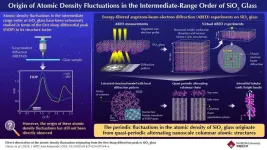(Press-News.org)
Although diet is the leading contributor to premature death from heart disease in the United States, fewer than one-quarter of people who undergo major heart events receive dietary counseling in the aftermath, a study finds.
The research, led by a team from the University of Michigan Health Frankel Cardiovascular Center, tracked nearly 150,000 patients seen at hospitals across Michigan for serious heart conditions — such as heart attack and heart failure — between late 2015 and early 2020.
Results published in Journal of the Academy of Nutrition and Dietetics, show that clinicians documented providing dietary counseling in just 23% of cases within 90 days of hospitalization.
Such counseling could have happened as part of a supervised cardiac rehabilitation program, or a separate kind of care called medical nutrition therapy.
That approach involves detailed nutritional assessments and targeted interventions led by registered dietitian nutritionists.
“Nutrition counseling may reduce the risk a person has for cardiovascular episodes and disease, yet our research shows that the vast majority of patients, who are all at risk after significant heart events, are not receiving this essential education,” said Brahmajee Nallamothu, M.D., M.P.H., senior author and professor of internal medicine-cardiology at U-M Medical School.
Most of the dietary counseling documentation was within cardiac rehab; the program itself is considered underutilized, as only around 20-30% of eligible patients participate.
When removing cardiac rehab from the equation, clinicians offered dietary counseling just 5% of the time.
The reason for such a low rate, researchers suggest, may be a lack of time for providing the counseling or expertise in this area by clinicians.
“When patients receive this education, we have seen tremendous results – some have cut cholesterol levels in half within weeks,” said first author Eric Brandt, M.D., M.H.S., FACC, director of preventive cardiology at the Frankel Cardiovascular Center.
“However, physicians are often limited by time required to manage other aspects of a patient’s condition. Additionally, most cardiologists do not receive sufficient education to provide the dietary advice themselves.”
Women, adults over 65 years old and patients with chronic kidney disease were all less likely to receive counseling from their providers.
Traditional Medicare participants were less likely to receive dietary counseling than patients with private insurance but more likely than those with Medicaid.
Currently, medical nutrition therapy is only covered for Medicare patients living with diabetes and end stage kidney disease.
“In my long history as a registered dietitian nutritionist, I have felt so grateful seeing how many patients benefit from medical nutrition therapy, yet my patients and I are equally saddened to see that the majority of people must pay out of pocket or be turned away because of lack of access to MNT services by Medicare,” said Geeta Sikand, M.A., R.D.N., FAND, a registered dietitian nutritionist and an associate clinical professor of medicine in the cardiology division at University of California, Irvine.
Nearly half of American adults have poor diet quality, yet many struggle to afford healthy foods. In 2022, the American Heart Association released a position statement supporting efforts to “increase equitable access to nutritious, affordable food” into health care delivery.
“Lifestyle is the cornerstone for preventing cardiovascular disease,” Brandt said.
“Without providing counseling on changing behaviors to choose the foods that our patients should eat, many are left without the tools to manage nutrition. I hope to see the landscape change where eating healthier is more well supported and achievable.”
Additional authors include Matthias Kirch, M.S., John Z. Ayanian, M.D., M.P.P., Tammy Chang, M.D., M.P.H., M.S., and Michael P. Thompson, Ph.D., all of university of Michigan.
This research was supported by the Blue Cross Blue Shield of Michigan Foundation.
Brandt reports research funding from the National Institutes of Health (K23MD017253) and the Blue Cross Blue Shield of Michigan Foundation.
Paper cited: “Dietary Counseling Documentation Among Patients Recently Hospitalized for Cardiovascular Disease,” Journal of the Academy of Nutrition and Dietetics. DOI: 10.1013/j.jand.2024.03.003
END
BOSTON—Healthy adults under the age of 75 are unlikely to benefit from taking more than the daily intake of vitamin D recommended by the Institutes of Medicine (IOM) and do not require testing for vitamin D levels, according to a new Clinical Practice Guideline issued today by the Endocrine Society. For children, pregnant people, adults older than 75 years and adults with high-risk prediabetes, the guideline recommends vitamin D higher than the IOM recommended daily allowance.
Vitamin D use and ...
Chocolate lovers may have been alarmed by a 2023 Consumer Reports finding that some dark chocolate brands could contain harmful levels of lead and cadmium.
However, a new study by Tulane University published in Food Research International has found that dark chocolate poses no adverse risk for adults and contains nutritionally beneficial levels of essential minerals.
The study sampled 155 dark and milk chocolates from various global brands sold in the United States and tested for the presence of 16 heavy metals ranging from the toxic (lead and cadmium) to the essential (copper, iron, zinc). The study then modeled the risk of eating one ounce of the chocolates per day which ...
Black patients with early-stage breast cancer who were treated with docetaxel chemotherapy every 3 weeks had less drug-induced peripheral neuropathy and significantly fewer dose reductions compared to those who received weekly paclitaxel, according to a trial by the ECOG-ACRIN Cancer Research Group (ECOG-ACRIN). Study EAZ171 is the first National Cancer Institute (NCI)-sponsored trial to focus specifically on enrolling a minority or underserved population to assess drug-induced toxicity (rather than drug efficacy) ...
In materials science, particularly in the study of glasses, the intermediate range order (IRO) is one of the most intriguing research areas owing to its significant influence over the physical properties of glasses. The IRO refers to the structural arrangement of atoms beyond the short-range order (atomic arrangement within a few atomic distances) but shorter than the long-range order (arrangement patterns over macroscopic distances). Notably, for covalent glasses, the IRO is marked by atomic density fluctuations.
Scattering experiments provide a distinct signature of ...
Crucial shift in River Nile’s evolution during ancient Egypt discovered
Researchers have explored how the River Nile evolved over the past 11,500 years and how changes in its geography could have helped shape the fortunes of ancient Egyptian civilisation.
Research published in Nature Geoscience reveals a major shift in the Nile around four thousand years ago, after which the floodplain in the Nile Valley around Luxor greatly expanded.
The findings raise the possibility that this shift could have contributed to the success of the ancient Egyptian agricultural economy at points between the Old and New Kingdom periods. ...
DARIEN, IL – A new study to be presented at the SLEEP 2024 annual meeting found robust evidence that implicates lower alertness, a key outcome of insufficient sleep, as a predictor of muted empathic responding, which suggests alertness may support both cognitive and affective empathy.
Results show that slower response times on objective alertness tests were significantly associated with lower levels of empathic concern, and that lapses and false starts on these tests were significantly associated with poorer empathic accuracy. Additionally, those ...
DARIEN, IL – A new study to be presented at the SLEEP 2024 annual meeting found that sleep apnea is associated with increased odds of future utilization of health care services including hospitalization among older adults.
Results show that participants aged 50 years and older with sleep apnea had a 21% higher odds of reporting future use of any health service compared with those without sleep apnea. Specifically, individuals with sleep apnea had 21% higher odds of hospitalization after controlling for potential confounders including demographics, body mass index, health conditions, and depressive symptoms.
“Our research indicates that older adults who have sleep apnea are more ...
DARIEN, IL – A new study to be presented at the SLEEP 2024 annual meeting found that most sleep tips shared on TikTok are supported by empirical evidence.
The research findings show that of 35 unique sleep tips shared in popular videos, there was empirical support for 29. Only six sleep tips were unsupported by scientific evidence.
“These results suggest that the sleep research and sleep medicine communities have done a good job of promoting appropriate tips for sleep hygiene,” said lead author Brian T. Gillis, who has studied sleep for eight years and is an assistant professor of marriage and family therapy in the College of Human Sciences ...
DARIEN, IL – A new study to be presented at the SLEEP 2024 annual meeting found that low-dose acetylsalicylic acid, also known as aspirin, can reduce inflammatory responses to sleep restriction.
Results show that compared with placebo, preemptive administration of low-dose aspirin during sleep restriction reduced pro-inflammatory responses. Specifically, aspirin reduced interleukin-6 expression and COX-1/COX-2 double positive cells in lipopolysaccharide-stimulated monocytes, as well as C-reactive protein serum levels.
“The novelty of this study is that it investigated whether we can pharmacologically reduce the inflammatory consequences of sleep restriction,” ...
A team of New York University researchers has created a new way to visualize crystals by peering inside their structures, akin to having X-ray vision. Their new technique—which they aptly named “Crystal Clear”—combines the use of transparent particles and microscopes with lasers that allow scientists to see each unit that makes up the crystal and to create dynamic three-dimensional models.
“This is a powerful platform for studying crystals,” says Stefano Sacanna, professor of chemistry at NYU and the principal investigator for the study, published in the journal Nature ...


